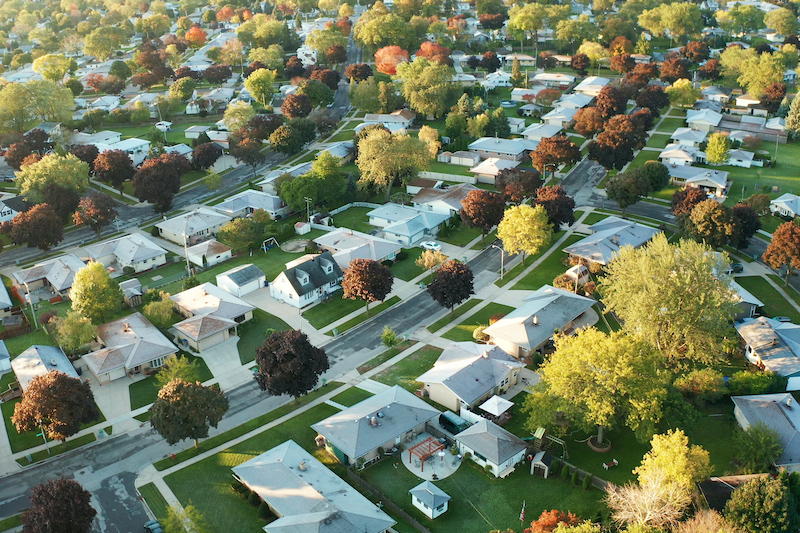COVID-19 Increases Appeal of Build-to-Rent

- The coronavirus threat has created investment opportunities with build-to-rent.
- More expensive markets are still looking at luxury as a differentiating product.
- Build-to-rent fundamentals offer advantages in today’s economy.
With the COVID-19 stay-at-home restrictions, more people are considering upgrading their housing. The lockdowns have been driving an uptick in online searches for apartments and single-family rentals (SFRs), according to real estate consultant John Burns.
“People are just sick of their tiny apartments. They’re sick of looking at their kitchens. They’re sitting in their houses looking at Architectural Digest,” said Burns, a speaker at an IMN “Build-to-Rent Market Insights” webinar. Panelists agreed that this is amplifying the appeal of build-to-rent.
Build-to-Rent Opportunities
Margaret Potter is the CEO of Camillo Properties, which builds, leases and manages single-family homes and townhomes in Texas. She noted her company owns about 14,000 lots with an additional 14,000 lots in the pipeline. Following the coronavirus pandemic, Potter is seeing more opportunities for acquisitions, with public companies trying to get out of land contracts. This has brought more Class A property onto the market, she said.
Large national builders are also picking up projects, with mid-size builders dropping contracts, said Jay Byc, cofounder of ResiBuilt Homes. His Atlanta-based company provides build-to-rent housing. He predicts a repricing of land. “But it’s probably not more than five to ten percent overall. In the grand scheme of the entire price of the house, it’s probably not going to be that dramatic,” he said. However, Byc also emphasized companies now have the opportunity to increase market share.
COVID-19 Is Changing What Tenants Want
“Variety is going to be the name of the game going forward,” said Mitch Rotta, director of new construction at Tricor, a Phoenix-based SFR contractor. Investors are diversifying their land strategies, mixing product types and looking at the life cycle of products.
“It’s been a pretty unique time, with people shifting their design strategies a little bit, not only from land and zoning and densities but also the product type itself,” said Rotta. As one example, people are now more often considering adding home offices, with housing coming online in 18 to 36 months.
Geographical Markets Affect Finances
Dennis Cisterna moderated the session. He’s the chief investment officer of Lafayette Communities, an SFR platform focused on build-to-rent. He pointed out how SFRs and new construction are harder to pencil in more expensive markets such as California, Southern Florida and Denver, Colorado.
“The rents don’t move in lock-step, so you have a natural compression of yields,” Cisterna said. As a response, some investors have modified their product. For example, in Phoenix, instead of traditional detached units, developers are building SFRs as small, detached or attached cottages with no garages. “The density is much higher. It’s essentially a horizontal apartment,” he explained.
Market by Market Differences
The panelists work in build-to-rent in Arizona, Texas, Florida, Georgia, the Carolinas and Tennessee, which Cisterna referred to as “bread and butter” states. He noted secondary and tertiary markets have picked up steam. But high impact fees and expensive costs of land have slowed the market in other areas.
“Once you get above the $250,00 to $300,000 price point for a house, yield just drops off a cliff,” he said. To counter this, in high-cost areas, developers have focused on luxury rentals to provide more of a discretionary choice compared to run-of-the-mill product.
Build-to-Rent Maintains Higher Leasing Velocity
Build-to-rent is larger, newer and generally more expensive than traditional single-family housing. Thus, demographically, the COVID-19 threat has had a lesser impact on build-to-rent tenants compared to other renters, commented Cisterna. Although Lafayette Communities experienced a slight dip in rental payments, he added that it was nowhere near what in early March they thought could happen.
In March and April, ResiBuilt leased 65 homes, said Byc. Supporting Cisterna’s observations, he stated that across the board with his company’s portfolios, tenants’ incomes average 5.5 to 6.5 times monthly rent. Their collection rate has remained nearly the same as in February, he said.
Similarly, demand at Camillo Properties remains at a record high, with occupancy across the company’s entire portfolio above 97%, said Potter. April rent collections dipped 3%, while the company has also seen rent increases and lease renewals.
Labor and Supply Challenges
Markets are experiencing labor shortages, and some municipalities are not set up to approve or inspect property, said Rotta. The coronavirus threat has created safety concerns that have delayed construction. However, he predicted that in the long-term, the disruptions would be a “hiccup.” Rotta emphasized how the industry has responded in positive ways—continuing business online, with meetings and even inspections in some cases.
Cisterna concluded the discussion by characterizing build-to-rent as a thriving, long-term product. “There’s a reason for that. There’s a great fundamental here. We are helping solve the affordable housing issue in America right now.”
You can listen to the full IMN webinar here.
Contact Arbor today to learn more about single-family rental portfolio solutions, including build-to-rent financing.

